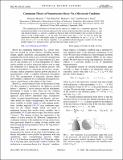| dc.contributor.author | Margetis, Dionisios | |
| dc.contributor.author | Fok, Pak-Wing | |
| dc.contributor.author | Aziz, Michael | |
| dc.contributor.author | Stone, Howard | |
| dc.date.accessioned | 2009-04-13T19:00:55Z | |
| dc.date.issued | 2006 | |
| dc.identifier.citation | Margetis, Dionisio, Pak-Wing Fok, Michael J. Aziz, and Howard A. Stone. 2006. Continuum theory of nanostructure decay via a microscale condition. Physical Review Letters 97(9): 096101-096104. | en |
| dc.identifier.issn | 0031-9007 | en |
| dc.identifier.uri | http://nrs.harvard.edu/urn-3:HUL.InstRepos:2794937 | |
| dc.description.abstract | The morphological relaxation of faceted crystal surfaces is studied via a continuum approach. Our formulation includes (i) an evolution equation for the surface slope that describes step line tension, g<sub>1</sub>, and step repulsion energy, g<sub>3</sub>; and (ii) a condition at the facet edge (a free boundary) that accounts for discrete effects via the collapse times, t<sub>n</sub>, of top steps. For initial cones and t<sub>n</sub>[approximate]t-tilde n<sup>4</sup>, we use t-tilde(g) from step simulations and predict self-similar slopes in agreement with simulations for any g=g<sub>3</sub>/g<sub>1</sub>>0. We show that for g>>1, (i) the theory simplifies to an equilibrium-thermodynamics model; (ii) the slope profiles reduce to a universal curve; and (iii) the facet radius scales as g<sup>-3/4</sup>. | en |
| dc.description.sponsorship | Engineering and Applied Sciences | en |
| dc.language.iso | en_US | en |
| dc.publisher | American Physical Society | en |
| dc.relation.isversionof | http://dx.doi.org/10.1103/PhysRevLett.97.096102 | en |
| dash.license | LAA | |
| dc.title | Continuum Theory of Nanostructure Decay Via a Microscale Condition | en |
| dc.relation.journal | Physical Review Letters | en |
| dash.depositing.author | Aziz, Michael | |
| dc.identifier.doi | 10.1103/PhysRevLett.97.096102 | * |
| dash.contributor.affiliated | Stone, Howard A. | |
| dash.contributor.affiliated | Aziz, Michael | |


